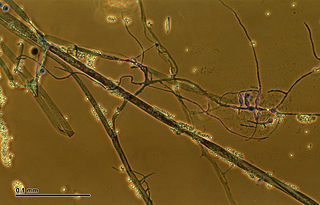Related Research Articles
Genus is a taxonomic rank used in the biological classification of living and fossil organisms as well as viruses. In the hierarchy of biological classification, genus comes above species and below family. In binomial nomenclature, the genus name forms the first part of the binomial species name for each species within the genus.
Giuseppe Gibelli was an Italian botanist and lichenologist who was a native of Santa Cristina e Bissone.

The hydnoid fungi are a group of fungi in the Basidiomycota with basidiocarps producing spores on pendant, tooth-like or spine-like projections. They are colloquially called tooth fungi. Originally such fungi were referred to the genus Hydnum, but it is now known that not all hydnoid species are closely related.

Thamnidium is a genus of fungi belonging to the family Mucoraceae.
Gnomoniopsis is a genus of fungi belonging to the family Gnomoniaceae.
Gibellulopsis is a genus of fungi belonging to the family Plectosphaerellaceae.
Benjaminiella is a genus of fungi belonging to the family Mucoraceae.
Deightoniella is a genus of fungi belonging to the family Magnaporthaceae.
Eiglera is a genus of fungi belonging to the family Acarosporaceae.
Aldridgea is a monotypic genus of fungi belonging to the Agaricomycetes class; it does not belong to an order or a family. Originally documented in 1892 by English mycologist George Edward Massee, it contained the single species Aldridgea gelatinosa. Presently, it consists of one species named Aldridgea ignatiana.
Aldridgea ignatiana is the lone species of fungi belonging to the Aldridgea genus. It was documented in 1959 by Brazilian mycologist Johannes Rick.
Anixia atrospora is a species of fungus belonging to the Anixia genus. It was discovered 1927 by French mycologist Narcisse Théophile Patouillard.
Anixia berkeleyi is a species of fungus belonging to the Anixia genus. It was discovered 1927 by Russian mycologist Nikolai Aleksandrovich Naumov.
Anixia buxi is a species of fungus belonging to the Anixia genus. It was documented in 1882. Its basionym is Orbicula buxi, which belongs to the Orbicula genus, but its taxonomy is uncertain.
Anixia interrupta is a species of fungus belonging to the Anixia genus. It was documented in 1832 by German-American mycologist Lewis David de Schweinitz.
Anixia minuta is a species of fungus belonging to the Anixia genus. It was documented in 1872 by Hungarian-Croatian mycologist Stephan Schulzer von Müggenburg.
Anixia myriasca is a species of fungus that belongs to the Anixia genus. It was documented in 1902 by Austrian mycologist Franz Xaver Rudolf von Höhnel.
Anixia nemoralis is a species of fungus belonging to the Anixia genus. It was documented in 1819 by Swedish mycologist Elias Magnus Fries.
Orbicula is a genus of fungi belonging to the Pyronemataceae family. It consists of two species. The type species is Orbicula cyclospora, now known as Orbicula parietina. The genus was documented in 1871 by English mycologist Mordecai Cubitt Cooke.
Hypolyssus is a genus of fungi belonging to the Agaricomycetes class; it has not been assigned to an order or a family. It consists of one species: Hypolyssus natalis. It was documented in 1825 by German mycologist Christiaan Hendrik Persoon.
References
- ↑ "Index Fungorum - Names Record". www.indexfungorum.org. Retrieved 2022-01-27.
- ↑ "Loading..." www.mycobank.org. Retrieved 2022-01-27.